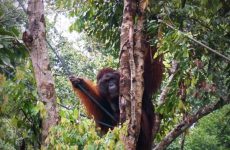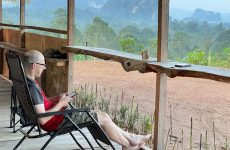
To Kiding with Engineers Without Borders (EWB) Australia
After a month’s gap, we were going back to Kiding village, only this time it’s with an even larger group. Meet Engineers Without Borders (EWB) Australia, our Australian partner for this trip, you can find out more about them here. EWB Australia has been in contact with us for the past two months leading up to the trip which we have just concluded last week. Given the small size of our company, we even wondered how they managed to find us in the first place. Nevertheless, we have managed to bring 11 Australian, 2 local engineering students, and 3 Australian facilitators to Kiding village to conduct their Humanitarian Design Summit project there. Here’s a recap of our journey + adventure.
Day 1 – Arrival
Ah the fresh air and cool temperatures. Our first day will always consist of a 2-3 hour hike to Kiding village, which is located at around 470 meters above sea level. Taking cue from our experiences last time round, we have opted to start our journey up much earlier, say 7:30 a.m. The group has been briefed on what to expect but they have yet to try the hike for themselves.
We all started out at the same time and as the hike went on, we started to see small groups of people forming up, each decided by the pace they are walking. We do have to say, the temperature around did make the hike much easier this time.
Under the warm but tolerable morning sun, and with the help of shades and pit stops, our group managed to scale the mountain in just over 2 hours. This an achievement considering it took us 3 hours the last time round. The view along the way was as usual beautiful but the best thing is everyone managed to make it up safe and sound.
In the village
After the hike up everyone just sort of relaxed at the chief’s house while waiting for the wonderful ladies of the house to prepare lunch. While the rest of the group were resting, we took the opportunity to discuss the plans for the next few days with Joli, the captain of the group. After discussions, it was decided that the group shall have opportunities to interact with different village members to understand the problems that they face, attend workshops conducted by the facilitators, tour around the village, as well as recreational activities.
After temperatures cooled down a bit, we proceeded with a village tour around the village. We first started with a visit to the church building of the village. The walk there was easy, crossing some bamboo bridges. The reason why we brought the group to the church was to show them the main place of worship for the villagers. We also want to show them the architectural design of the place.
After the visit to the village church, we took a slight hike to the village view point and the view was stunning as usual. Our guests were all in awe of the sight of the Padawan mountains in full from the view point. Not surprisingly, everyone whipped out their cell phone cameras and started taking pictures of the mountain range.

We spent a good 15 minutes at the viewpoint before resuming the tour. We made a pass at our friend Jirung’s house, which is still quite new and good looking. The students were also to curious to see the face of a local politician adorning the walls of the house. We explained to them that the state election was only last month and those were the promotional materials distributed to the villages.
Throughout the tour we managed to explain to the group the architecture of the village buildings. There are some of the landmark buildings which include the old village ceremonial house, the pangah. After the villagers converted to Christianity, the house which contained human skulls were no longer opened. The last ritual leader has passed away without inherited the leadership to anyone. Everyone has left the pagan ritual.
As we got back to the village, we were told that the we can finally move into the different houses which we will be staying in for the rest of the week. The chief’s house would be our meetup point with some girls heading to the house next door and some boys heading to another house which is about 2 minutes away. At 7 p.m we all gathered at the chief’s house again for dinner, before proceeding to visit one of the villager’s house, which also happened to be Jirung’s uncle. Only half of the group decided to join in as some of the students were a rather tired after a long day of hiking and walking about.
Community Engagement Continued
Once we arrived at the house, we were greeted with the usual warm reception by the people of the house. There we sat down and began chatting with the hosts about their daily life, occupation, and problems they faced. Mr Slay which is the deputy village chief, Jirung’s uncle as well as the head of the house, gave a lot of valuable insights of life in the village to the group, which enhanced their understanding of the culture of the local people. Mr Slay’s father-in-law, Mr Gud also decided to hop right into the discussion by showing the group his home made tobacco pipe, called the Supak. We spent a good 2 hours chatting and enjoying the hospitality of the hosts before we had to bid them goodnight in favor of some rest to recharge.
Day 2
It’s Saturday and we all gathered at the chief’s house for breakfast. We planned to go to our friend Jirung’s house which is located near the village viewpoint, to visit his father which would show us his wine brewing skills and a visit to his farm and village dam. We had a good breakfast and before moving to our next location, the group decided to play a game on the chief’s front porch, just to warm things up a little.
Visiting the Farm
After that we met up with Jirung’s father at his house, and after waiting a while for him to ready his gear, we started trekking to his farm area.
The farm trek wasn’t that difficult considering what we went through the day before. It still required us to be 100% focused on the road as some part of it is very narrow and next to a cliff. One of the students missed a step and fell off the clift. Luckily the vegetation beside the cliff prevented her from falling through and we managed to pull her back up safely. It was a scare but it didn’t spoil the overall mood of the trip. The view though, was still magnificent, even though we were not at the viewpoint.
At the Pepper Farm
Upon arriving at the farm, Jirung’s father revealed to the group that the task that they are going to perform today is planting a new pepper plant into the farm ground. The materials provided was quite limited and so we asked for a volunteer from the group to perform a demonstration. Lawrence who has been very active since arriving, jumped at the chance and was immediately seen pouring his sweat and tears into shoveling the soil. With the close supervision of Jirung’s father, he carefully inserted the seedling into the soil and install protection cover on top of the supporting mast. Jirung’s father also took the opportunity to explain about the nature of pepper plants, the distance between each pepper plant (6 feet to be exact), as well as the exact angle and position of the protective shade.
Brewing Ijok Wine
Once we’re done at the farm, we headed back to Jirung’s house to join in the distillation process of Jirung’s father’s famous Ijok drink. Ijok is type of wine produced by boiling and condensing the Nyok tree sap. The process of producing this Ijok drink is rather tedious and requires a high level of skill and mastery, thus there are very few people who still knows how to produce this specialty drink nowadays. The process was started when Jirung’s father boiled the raw tree sap using a big cooking wok. He said that the drink has to be boiled to a very high temperature before the condensation process can start.
After the sap reached their boiling point, Jirung’s father initiated the condensation process. First he put a large wooden drum on top of the boiling wok. Then he attached a smaller wok on top of the drum and ran cold water through it. The wooden drum had a tube extending outside and a smaller tube attached from the inside of the bigger tube. The explanation was rather mind blowing and it completely wowed everyone who was watching the process. The Ijok raw sap would evaporate through the drum in which it will rise to the bottom of the metal wok on top. The cold running water on top will condense the evaporated Ijok in gas form back to liquid. The liquid will then drip into the tube extending outside through a mechanism inside the drum and flow into bottles already on standby. That was local engineering ingenuity at its best!
Tasting Ijok for the First Time
On top of that, the group also had the opportunity to try the freshly brewed drink and compare it with the fresh unprocessed sap. The students commented that the drink was actually quite light and tasted quite good.
Visiting Village Dam Site
After the session with the Ijok drink, Jirung’s father proceeded to filling up all his empty bottles with the drink and stored them inside the house. Before long, we were ready to go and have a look at the new village dam. We were all convinced the journey there would be a breeze as Jirung’s father said it would only take around 15 minutes of walking.
OH BOY were we wrong about the statement! The journey there eventually took half hour to reach the said destination and that was the time we learned that the locals have a different set of timing to estimate distance. We bore no grudge however, as the group managed to have a good look at the structure of the dam. By the time we arrived the filtering system still hasn’t been installed even though the structure can be considered to be complete. The dam will provide fresh water supply to the village, supplementing the existing two dams.
A trek back to the chief’s house, some siesta time, dinner and discussion at night eventually concluded an eventful day.
Day 3 – Work Hard, Play Hard
Throughout our stay the village, the participants had their fair share of brainstorming and generally hard at work in scouting around the village to look for design opportunities, as well as interviewing villagers their opinion on their prototype designs. All those hard work and no fun would have been very cruel to the group and thus, we have already arranged a trip to Tanju waterfall beforehand.
Day 4 – Waterfall Trekking
At 7:00 a.m on a beautiful Monday, we were all ready to conquer the 3 hour trek to Tanju waterfall. We packed our lunch and an extra bottle of water into our backpacks. Once our guides were arrived at the chief’s house, we were swiftly on our way. The trek to the waterfall was made much easier with the apt timing of our starting time. The cooler temperatures helped a lot in conserving energy. The continuous dry weather also helped in making the pathways solid and not as slippery as last time round. The group took their time and even had the time to chat along the way.
Reaching Tanju Waterfall
Without even realizing it has already been 2 and a half hour, we saw the familiar sight of Tanju waterfall. From first glance the waterfall looked slightly different, seemingly smaller than last time; perhaps due to the dry weather lately. Nevertheless, the slightly smaller waterfall did open up the previously inaccessible flat ground, which earned the waterfall its name due to its resemblance to the bamboo porch of the Kiding houses. The true beauty of the place cannot be expressed by words alone so we will let the pictures we took do the talking.
Once the relaxation and lunch at the waterfall were accomplished, the group members readied themselves to go back. After a nice chilling dip at the waterfall, everyone was rightly in high spirits.
And so it went, we were on our way back from the waterfall to the village. The group was actually quite glad to see some of the tiresome zinc roof tops of the village as it meant that they were once again back with civilization. Everyone was elated with the trek and were seen sharing stories with one another.
Day 5 – Last Day before Leaving the Next Morning
For our last day at the village, we have arranged something special for our guests and that was, to have a blow-pipe competition in the morning, at the chief’s house front porch. Everyone was just eager to get the competition started. All want to see who can master this traditional hunting weapon better. The competition format would be single knockout for the first two rounds before deciding on the top 3 to face off against each other, with 3 darts given to each person to get the highest score. We even got our local guides to join in the fun!
Blowpipe Championship
And after rounds and rounds of blowing darts off the pipe, one of the local students in the team, Iziani won the competition to be crowned the one and only champion of EWB Blowpipe Championship!
Weaving Class
With the competition done and dusted, we moved on to the next house which was the girls’ lodge for the trip. Our purpose was to show the team some of the local handicraft techniques as well as the presenting them the opportunity to learn from the experts. After a brief explanation and demonstration, the students were broken into smaller groups, with each given some material to weave from. Their goal was to create a piece of mat from local materials.
The end result weren’t too shabby at all. The groups were very good in working with the materials, albeit still needing some help from the lady experts with the corners.
Time to Get Serious with Work Again
The day proceeded with some more workshops and discussions for the students to finalize their prototype designs. We even managed to help them to talk to some more villagers to get more opinion on their designs. That evening, we went up again to the viewpoint to conduct the last workshop session of the trip. Everyone got to share their most memorable experiences throughout the last 5 days and we even got to take a group photo with the Padawan mountains as our backdrop.
Special Dinner
Dinner was rather special for this night, as the hosts went all out to prepare a farewell feast for the group. We were surprised with the amount that have prepared, but accepted the generosity nonetheless, it was delicious and everyone had their fair share of food.
One Last Chance to Introduce Bidayuh Traditional Costume
Upon nightfall after dinner, the host next door invited the girls in the group to try out some of the Bidayuh traditional costume that is unique to the tribe in that particular region. As opposed to having the more common black top with red linings, the Kiding ladies wear white tops instead. The girls took turn to try on the costume and we even had a special guest; an elderly lady from the village, dressed in her full set of traditional costume. As an end result, we all managed to take some beautiful photos, a fitting end to a wonderful trip with these people!
Day 6- Time to Say Goodbye
It was again, 7 a.m in the morning. We’ve all had our breakfast at the chief’s house and it was finally time to say goodbye to the village. As one of the students was unable to walk down on her own, we had to go down in two separate groups, with one group leaving earlier on foot and the other, which was us, leaving later in the afternoon via a pickup truck. It was hard saying goodbye to everyone as we’ve already formed friendships with the team. We do have them to thank for such a wonderful opportunity to work with so many awesome people and it helped us to see things in so many different perspectives. With that being said, we do hope that we would be able to work with them again in the future!



